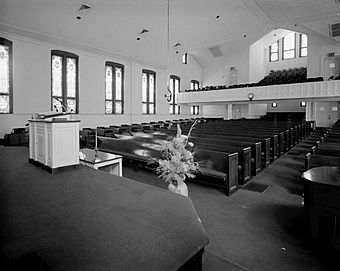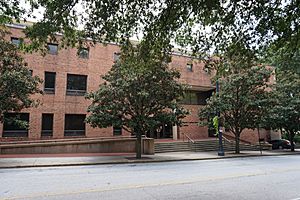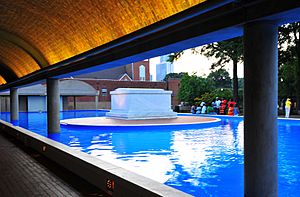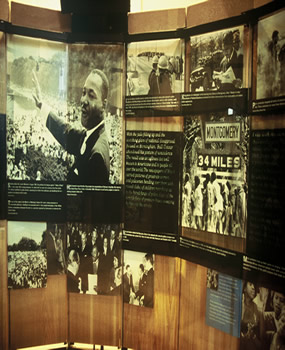Martin Luther King Jr. National Historical Park facts for kids
|
Martin Luther King Jr. National Historical Park and Preservation District
|
|

Interior of Ebenezer Baptist Church, view from behind the pulpit
|
|
| Location | Roughly bounded by Courtland, Randolph, Chamberlain Sts. and Irwin Ave. (original) and Roughly bounded by Freedom Pkwy., John Wesley Dobbs Ave., Decatur St., Southern RR tracks, and I-75/85 (increase), Atlanta, Georgia |
|---|---|
| Area | 34.47 acres (13.95 ha) 13.04 acres (5.28 ha) federal |
| Built | 1929 |
| Architect | Multiple |
| Architectural style | Late 19th and early 20th century American movements, Modern movement |
| Visitation | 624,848 (2005) |
| Website | Martin Luther King Jr. National Historical Park |
| NRHP reference No. | 74000677, 80000435, 00000741 |
Quick facts for kids Significant dates |
|
| Added to NRHP | May 2, 1974 (original) June 12, 2001 (increase) |
| Designated NHLD | May 5, 1977 |
| Designated NHS | October 10, 1980 |
The Martin Luther King Jr. National Historical Park in Atlanta, Georgia, is a special place that honors the life and work of civil rights leader Martin Luther King Jr.. This park covers about 35 acres and includes several important buildings.
You can visit his childhood home and the original Ebenezer Baptist Church, where King was baptized. Both his father, Martin Luther King Sr., and he served as pastors at this church. It's a key part of understanding King's journey and his fight for equality.
Contents
Exploring Martin Luther King Jr.'s Legacy
These important places help us learn about Martin Luther King Jr. and his role in the Civil Rights Movement. They were first recognized as a National Historic Site in 1980. Later, in 2018, the area was expanded and became a National Historical Park. This change was supported by a bill signed by former President Donald Trump, championed by civil rights leader John Lewis.
The park's visitor center has a museum that tells the story of the American Civil Rights Movement and Martin Luther King Jr.'s path. The King Center for Nonviolent Social Change is also part of the park. It is the burial place of King and his wife, activist Coretta Scott King.
An old firehouse from 1894, called Fire Station No. 6, used to serve the Sweet Auburn community. Today, it has a gift shop and an exhibit about desegregation in the Atlanta Fire Department. The park also features the "I Have a Dream" International World Peace Rose Garden and a memorial to Mahatma Gandhi. You can also find the "International Civil Rights Walk of Fame" here, which celebrates brave people who worked for social justice.
In 2019, the National Park Foundation bought the home where Dr. King's family moved in 1965. This home on Sunset Avenue will become part of the park after it is restored.
Each January, large crowds gather for events celebrating Martin Luther King Jr. Day. Important speakers, including U.S. Presidents and civil rights leaders, often attend. Special events also happen during Black History Month in February and on the anniversary of King's assassination in Memphis, Tennessee, on April 4, 1968.
Preserving History
The Martin Luther King Jr. Historic District was added to the U.S. National Register of Historic Places in 1974. This district includes Ebenezer Baptist Church, King's grave site and memorial, and his birthplace. It also features different types of historic homes, like shotgun row houses and Victorian houses. Other notable buildings are Our Lady of Lourdes Catholic Church and Fire Station No. 6.
Much of this area became a National Historic Landmark district in 1977. Over the years, The Trust for Public Land bought several properties to create a parking lot and a walking path. This path connects the King district to the Jimmy Carter Presidential Center.
In 1980, the site became a national historic site by U.S. law. The National Park Service (NPS) manages it. In 2018, it was renamed a National Historical Park, and the Prince Hall Masonic Temple was added to the protected area.
Martin Luther King Jr.'s Birth Home
King's Birth Home is at 501 Auburn Avenue in the Sweet Auburn historic district. Built in 1895, it's about a block from Ebenezer Baptist Church. King's grandparents bought the house in 1909. In 1926, King's parents moved in, and King Jr. was born there in 1929.
The King family lived in the house until 1941. Later, it was divided into two apartments. Dr. King's brother, Rev. A. D. Williams King, lived on the second floor in the 1950s and early 1960s.
The first floor has a front porch, parlor, study, dining room, kitchen, laundry, bedroom, and a bathroom. The second floor has four bedrooms and another bathroom. The park's visitor center offers free tours of the house, led by National Park Service rangers. However, these tours have limited availability.
The King Center
After King's death in 1968, Coretta Scott King founded the Martin Luther King Jr. Center for Nonviolent Social Change, also known as the King Center. Since 1981, the center has been in a building next to Ebenezer Baptist Church on Auburn Avenue.

In 1977, a memorial tomb was built for King. His remains were moved there, to a plaza between the center and the church. King's gravesite and a reflecting pool are next to Freedom Hall. After her death in 2006, Mrs. King was buried with her husband. An eternal flame burns nearby.
Freedom Hall, at 449 Auburn Avenue, has exhibits about Dr. and Mrs. King, Mahatma Gandhi, and American activist Rosa Parks. It hosts special events and programs focused on civil rights and social justice. The hall includes a large theater, a bookstore, and art from around the world.
In 1990, a statue called Behold, honoring Martin Luther King Jr., was placed near Ebenezer Baptist Church.
Visitor Center
The visitor center, built in 1996, is located at 449 Auburn Avenue. It features a cool exhibit called Courage To Lead. This exhibit shows how Dr. Martin Luther King Jr.'s life and the Civil Rights Movement developed side by side. Visitors can also walk along a path called "Freedom Road."
There's also a special exhibit for younger visitors called Children of Courage. It tells the stories of children who were part of the Civil Rights Movement. It also encourages today's youth to make a difference. The center offers ongoing video programs and has a helpful information desk.
Gandhi Promenade
A statue of Mahatma Gandhi was given to the park by the Indian Council for Cultural Relations. It reminds visitors of Gandhi's ideas about nonviolence. A bronze plaque on the statue includes quotes from both Gandhi and Martin Luther King Jr. about the power of nonviolence and its importance for human progress.
International Civil Rights Walk of Fame
The "International Civil Rights Walk of Fame" was created in 2004. It honors many people who took part in the Civil Rights Movement. The walk, along the Promenade, has granite and bronze markers shaped like footsteps. The National Park Service says the Walk of Fame was made to "pay homage to the 'brave warriors' of justice." These individuals sacrificed and worked hard to make equality real for everyone.
This "Walk of Fame" was the idea of Xernona Clayton, a civil rights activist. She wanted it to be a lasting memorial to those who showed that human progress doesn't happen on its own. This historic site is meant to be a symbol of pride and hope for future generations.
Prince Hall Masonic Temple
The Prince Hall Masonic Temple, at 332 Auburn Avenue, is a very important building. In 1957, the Southern Christian Leadership Conference (SCLC) started its first headquarters here. Dr. King helped create this civil rights organization and was its first president. The building is owned by the Most Worshipful Prince Hall Grand Lodge of Georgia. It became part of the park in 2018.
Photo gallery











